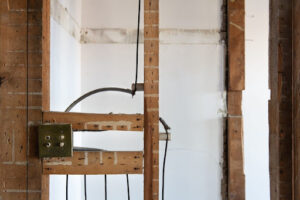As a homeowner, one of the essential aspects of maintaining a safe and efficient home is by ensuring your electrical outlets are updated and functioning well. Electrical outlets are the primary means of delivering power to our electronic devices, appliances, and lighting fixtures. Outlets can last a long time without showing any sign of wear or tear, but on average, they need to be replaced every 20 years.
In this blog post, we will discuss how to install an electrical outlet and why it’s essential to replace your old outlets. We will also look at the failure of backstabbing and why it’s best to attach the wires to the screws.
How to Install Electrical Outlets
The first step in installing an electrical outlet is to turn off the power supply. Flip the circuit breaker to the outlet off position or remove the fuse in the fuse box that controls the outlet’s electricity.
Use a voltage tester to test the outlet to ensure that there is no power running through it. Unscrew the outlet plate cover and take a look at the wires. You will notice the electrical wires connected to screws behind the outlet.
Loosen the screws with a screwdriver to create an opening that can accommodate the plug. Before you tighten the screw, make sure the wire is attached. The black wire is the “hot” wire, the white wire is the “neutral” wire, and the green wire is the “ground” wire.
Strip the wires about 3/4″, wrap it around the screw in a clockwise direction, and screw it tightly. Push the outlet and plate securely back into the box, fasten the screw plate, and you’re good to go!
It’s Essential to Replace Old Outlets
It is vital to replace old electrical outlets every 20 years. Over time, the connections loosen, the wiring insulation wears down or erodes away, and the plastic casings crack. Older outlets pose a fire hazard risk and can damage your appliances and devices.
Furthermore, new technology has created electrical outlets designed to improve electricity usage efficiency and serve as added convenience for homeowners. For instance, USB outlets now allow homeowners to charge their phones, laptops, and other devices.
Backstabbing Failure
Electricians originally designed backstabbing as a quick and easy way to connect wires to an outlet. Backstabbing involves inserting wires into a pre-cut hole at the back of the outlet, which automatically cuts the insulation and makes contact with the wire to conduct electricity.
However, backstabbing significantly increases the likelihood of the wires loosening or coming undone over time due to the pressure placed on the wires from the hole where it was forced through. This risk makes it unsafe and ineffective to use.
Don’t Be Afraid to Call a Professional
If you have two-pronged outlets installed in your home, it is best to call a professional electrician to replace those outlets. These outlets do not have a grounding wire, which makes them a significant risk for electric shock. The electrical outlet professionals have the expertise and experience to handle difficult installation services securely and timely.
Conclusion
In conclusion, electrical outlet safety and efficiency are necessary for every homeowner. Fortunately, replacing an electrical outlet is a simple process that does not require a lot of work. It is, however, essential to replace these outlets every 20 years to ensure your safety and avoid fire hazards. Furthermore, backstabbing is unsafe, and it’s best to attach wires using screws securely. Hiring an electrician can help you avoid costly mistakes and increase the lifespan of your outlets. We hope this helps educate homeowners on how to install and maintain their electrical outlets.






